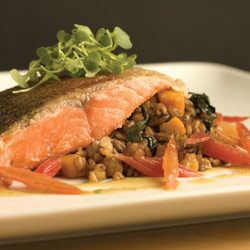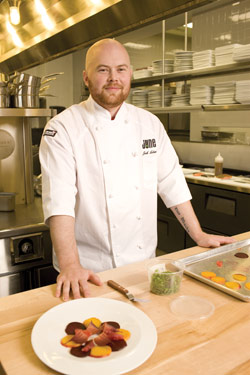June

Innovation: the introduction of something new; a new idea, method or device.
Innovation is a term most often associated with science and technology, but as Josh Adams, owner and executive chef of June Restaurant in Peoria Heights, knows, it can apply equally to cuisine and the ways in which it is prepared.
A Lab in the Kitchen
At June, Adams employs a cooking method called molecular gastronomy, a term which he claims is somewhat overused. “I think that word gets thrown around a lot, but [it’s mainly] a scientific approach to cooking. That’s how we look at everything.” Adams explains that while many chefs use traditional cooking methods because they are just that—traditions, he looks for the optimum way to cook each dish.
Searching for those methods is how Adams came to molecular gastronomy. “The more chefs you work for,” he said, “you find out that everyone does everything differently.” Adams believed there had to be a “right” way of doing things and went searching for those answers.
That is exactly how Heston Blumenthal came to molecular gastronomy. Blumenthal, a.k.a. “The Fat Duck,” is a British chef considered to be one of the two greatest chefs in the world, the other being Spanish chef Ferran Adria. “They’re the ones who made [molecular gastronomy] famous and what it is,” stated Adams. Greatly influenced by Blumenthal himself, Adams believes The Fat Duck has one of the most scientific approaches to cooking of any chef. He noted that Harold McGee’s book, On Food and Cooking: The Science and Lore of the Kitchen, was also a major influence.
Precision is Key
The scientific approach to cooking relies on precision and is extremely consistent. When I arrived at June for a mid-afternoon interview, Adams and his staff were deep into preparations for that night’s guests. He showed me around the kitchen, placing special emphasis on a couple of the innovative machines they employ—a vacuum sealer and a circulator, or water bath. I didn’t know it at the time, but I was being introduced to sous vide—French for “under vacuum”—a cooking method that vacuum-seals meats and vegetables in plastic bags and cooks them for extended periods of time in precisely heated water. The bath was full of vacuum-sealed lamb shanks immersed in water, set to a constant temperature of 147.2 degrees Fahrenheit—precision. According to Adams, that particular type and cut of meat is done after exactly 72 hours at that temperature.
“The nice thing about sous vide is the nutrients aren’t lost [since] it’s under a vacuum,” said Adams. “Normally, a lot of nutrients would escape through evaporation, but now they’re all forced to stay in there, so the flavors are intensified too.” While food cooked in circulators is tastier and more nutritious, its appearance often leaves something to be desired. Because no browning reaction takes place, it’s necessary to finish each piece on a grill or griddle to “give it that crust,” as Adams explained.
When grilling a piece of meat using traditional methods, it is cooked until the center reaches a certain temperature, which tends to overcook the outsides. One must have “that touch and intuition and experience of knowing how to do it,” said Adams. With molecular gastronomy, however, meat is cooked evenly, at the temperature at which it should be done, avoiding overcooking.
Not only is this scientific approach to cooking healthier and more nutritious, but according to Adams, it’s more organized and consistent as well. While many chefs don’t appreciate the fact that such consistency can allow an untrained person to produce the same result as a professional, Adams believes it provides him more freedom and better organization.
“If you walked in here,” Adams illustrated, “I could say, ‘Here’s the circulator, here’s a piece of meat. Vacuum-seal this, cook it for an hour and a half, add this many grams of salt’ (because I know it’s this many grams of salt for the weight of the meat so it’s perfectly seasoned). You could seal it; you could walk in the back, and I could say ‘550-degree blanch, sear it for 20 seconds on each side, baste it with a little butter.’ You could do that just as well as I could. It would be the same as if I did it, and you didn’t go to school to learn to be a cook.”
Innovation and Efficiency
The approach to cooking used at June also makes serving guests more organized and efficient. After coming out of the circulator, “it may take 40 seconds to sear a piece of meat,” Adams said, “before it’s plated and sent out to the dining room. It’s quicker.”
Because food cooked using molecular gastronomy is done at a specific time, there can be a lag time between when the food is done perfectly and when a guest orders the dish. In these instances, the meat is chilled and rethermed at the proper time. Adams and his staff use an innovative process for this task as well.
Meat is cooled at room temperature for 15 minutes, then chilled in an ice-water bath, and finally placed into a blast chiller set at –36 degrees, where several fans blow on the meat at once, freezing it in five or 10 minutes. “It’s a really intense piece of equipment,” reported Adams, “because of the way it can freeze things so fast. You can’t do that with the traditional technique, which is to drop it in an ice-water bath. This is three times faster.”
Initially cooling the meat in cold water is very important because it helps the meat reabsorb its juices. If this step is skipped and the meat is placed directly in the blast chiller, the outside would freeze first, making it impossible to reabsorb the juices. “You mess up the cooling process, and you ruin the meat,” Adams explained. “That would be really unfortunate after spending 72 hours cooking it.”
To bring the meat back to a plate-ready state, it’s returned to the water bath, making sure to never exceed the temperature at which it was originally cooked. This can take anywhere from 15 to 30 minutes, depending on the type and cut of meat, and is staggered throughout dining times so guests aren’t kept waiting too long for their food.
Creating Interesting Textures
Another innovative culinary technique employed at June is the use of hydrocolloids, ingredients used to manipulate foods and achieve different textures like airs and foams. Adams explained that hydrocolloids allow him to turn bacon fat, olive oil or pine nuts into powders that rehydrate in your mouth. “It’s just interesting textures that you wouldn’t be able to achieve in any other way…and often times, you get a better flavor release,” he explained. While these are great accents, their main function is to showcase the main dish.
Hydrocolloids allow Adams to get creative with his dishes and craft interesting combinations that are otherwise impossible. For example, he sometimes pairs a mint air with hot spices—the idea of using polar opposites to create a reaction in the mouth. Adams notes that this gives him “more textures, more options and more things to do.”
All of these techniques would be for naught if it weren’t for the fresh ingredients Adams insists upon using at June. According to the chef, you must have great ingredients when using molecular gastronomy methods because flaws are much more evident when using lesser-quality ingredients.
Direct From the Farm
Adams’ love for fresh, organic ingredients was learned at a young age from his mother. As a chef, he realized the benefits of cooking with high-quality ingredients were many, so he has made a firm commitment to using farm-fresh ingredients.
Locally, Adams has partnered with an organic farm in Princeville called Thunder Valley, which has dedicated 80 of its acres to growing food for June. But because it doesn’t produce year-round, Adams also works with Chef’s Garden in California, the self-proclaimed “leading grower of artisanal products in the United States for the world’s top chefs.” This produces high-quality, fresh ingredients year-round, which Adams relies on in the winter months.
Adams and his staff also implement age-old techniques to preserve locally grown ingredients. “We’ll preserve Meyer lemons and use them throughout the spring and summer. The idea is you can always take [a] season and continue it on by preserving, pickling, salt curing.”
Taking the best of the old and the new—both innovative and age-old culinary techniques—June is a hit in the Heights. Adams’ scientific approach to cooking offers a dining experience full of unique tastes and textures, sure to please every taste bud. iBi


